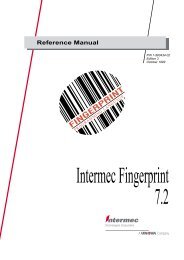9560 Transaction Manager User's Manual - Intermec
9560 Transaction Manager User's Manual - Intermec
9560 Transaction Manager User's Manual - Intermec
You also want an ePaper? Increase the reach of your titles
YUMPU automatically turns print PDFs into web optimized ePapers that Google loves.
Data Communications and Operating Options<br />
5<br />
Asynchronous protocols at this level perform error detection. For synchronous<br />
protocols, this layer detects starting and ending flags and generates a cyclical<br />
redundancy check (CRC). This layer also identifies whether the transmission<br />
channel is dedicated (point-to-point) or shared (multipoint), and if transmission<br />
is full- or half-duplex.<br />
Full-Duplex Protocols Versus Half-Duplex Protocols<br />
At the data link layer, protocols are described as either full-duplex or halfduplex.<br />
A full-duplex protocol allows messages to be received and transmitted<br />
simultaneously. Your system must have separate, dedicated channels for<br />
receiving and transmitting data to use a full-duplex protocol. Also, the host<br />
and reader must have the necessary hardware (interrupt structure) to support<br />
receiving and transmitting data simultaneously. You define a full-duplex<br />
protocol by disabling both the solicitation sequence (Poll and Select) and<br />
AFF/NEG handshakes.<br />
Point-to-Point and similar user-defined protocols are the only <strong>Intermec</strong><br />
protocols that are full-duplex. These protocols do not support retransmission of<br />
data messages. The reader transmits data when commanded to by the<br />
operator, but the reader receives data from the host at any time.<br />
A half-duplex protocol requires that only one device transmit data at a time<br />
over a shared or dedicated channel. You can use a half-duplex protocol over a<br />
full-duplex medium, but only one device at a time can transmit data. You<br />
define a half-duplex protocol by defining either the POL character or the<br />
AFF character.<br />
Full-Duplex Devices Versus Half-Duplex Devices<br />
Devices are full-duplex or half-duplex depending on their ability to receive and<br />
transmit data simultaneously. Both hardware and software design determine if<br />
a device is full or half-duplex. A full-duplex design requires a hardware UART<br />
(universal asynchronous receiver/transmitter) with double-buffered transmit<br />
and receive buffers. The UART signals the CPU when a character is received or<br />
when the transmit buffer is ready for another character. The software must<br />
perform the transmit or receive functions when the UART signals the CPU<br />
with an interrupt.<br />
The DLE Character and XON/XOFF Flow Control<br />
You use the DLE (data link escape) character to send protocol commands or<br />
parameters that you want to be treated as data. The DLE must precede the<br />
transparent command or parameter. The following protocol parameters are<br />
considered transparent if DLE is enabled: RES, REQ, SOM, TX EOM1,<br />
TX EOM2, and XON/XOFF.<br />
You can send the DLE, EOR (end of record), and EOF (end of file) characters as<br />
data if each is preceded by an DLE.<br />
5-5
















